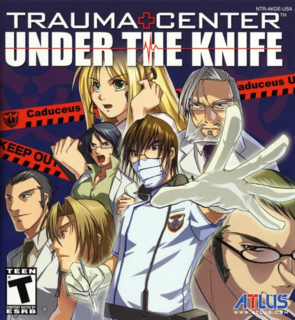In order to save your patients, you must exercise patience.
You take on the role of Derek Stiles, a young resident of Hope Hospital in fictional 2018 Angeles Bay, California. Still having trouble adhering to strict protocol, Derek tries to do his best to prove to his staff that he has the makings of doctor. With the help of his nurse Angie, he saves a few lives, awakening an innate ability known as The Healing Touch in the process. Because of his exceptional skills, he's garnered the attention of a disease treatment center known as Caduceus. Soon, Derek finds himself utilizing every skill he knows to combat a highly contagious and deadly disease known as GUILT.
Trauma Center: Under the Knife plays out like a visual novel. The game features six chapters, and each chapter is broken up into episodes. Some episodes are nothing but exchanges of dialogue between characters, while some will contain actual gameplay levels. Before you begin an operation, you'll be briefed with what you're going up against, and your nurse will aid you along the way.
The gameplay has you performing operations on patients with numerous conditions and symptoms. You start off each patient by making an incision, and then the game zooms in on them. Their vital organs become your playing field, and you have a number of tools at your disposal, the most important being the scalpel. You can apply antiseptic gel to infected areas, suction away fluids, clamp gaping wounds, burn growths with lasers, scan with an ultrasound, and suture and bandage wounds to finish up the level.
Each level has three critical limits that cannot be exceeded if you wish to succeed. There's the time limit (most levels are five minutes long), mistake limit, and vitals limit. If you miss, say pulling out a shard of glass wrong, that's a strike against you. When there's a disease or injury to the patient, the patient's vitals begin to drop, so you'll have to inject them with an adrenaline-like medicine.
Sometimes you can be hit with a number of complications at once, dropping the vitals down faster than you can bring them up, and that's where the Healing Touch comes in. If you tap on the Hand icon (which is used for massaging the heart, and putting into place grafts to patch up holes), it turns into a Star icon. If you draw a star on the screen, time slows down to a crawl. You should then be able to keep the patient alive long enough to administer the proper treatment and end the level. Your score is of course docked for using the ability, but it's nice to have in a bind when you're just not fast enough.
The operations become increasingly more complex and difficult, as the game introduces GUILT, which the majority of the story revolves around. GUILT is an ever evolving bioengineered disease, which was released on the public as a biological weapon. Each different strain of the disease presents its own challenges and requires different ways to eradicate it. Some of the later levels become so excruciatingly difficult, the average gamer will feel completely overwhelmed and may just give up. In order to really be successful in this game, you have to be good at multitasking, micromanaging, and above all have patience. When you finally overcome a trying operation, you'll definitely feel good about it, though.
You can play through any operation you've completed again at any time via the game's Challenge Mode. Every level is ranked from C through S, with S being the highest rank. Also, you'll unlock a new set of challenges after beating the game, but they are nothing new, just far more difficult GUILT battles of strains you already encountered. It's a true masochist's paradise.
For a first generation Nintendo DS title, the visuals aren't that bad. It clearly won't show off the power of the platform because of the simple nature of the game. It does what it's meant to do well enough, and that's to render bodies and organs to operate on. If you're looking for impressive textures, you're just not going to find them here. The special effects are average, doing just enough to show off rips of organ tissue and profuse bleeding, but nothing that resembles anything photo realistic. In case you're wondering, although you do operate on naked patients, no private parts are rendered, especially since some patients are children.
The audio is about as average as the game's graphics. When you're cutting with the scalpel, it almost sounds like you're tearing through paper instead. When the patient gets injured, either from the GUILT or by you, it sounds more like an action movie. The burning of the laser and the suction of the drainage tube sounds decent enough, though. There is no voice acting at all, so if you're bothered by having to read character dialogue, you might not enjoy the game as much. The music is standard fare, about as fitting for a visual novel as one could imagine.
There aren't many games like Trauma Center available out there, so if you want to play a game that lets you get the feel of what being a doctor is like (although a lot of the medical technology is completely fictional), Trauma Center is worth a play. You have to be warned, though, it's a very tough game. One reason why it's so tough is because it requires ABSOLUTE precision with the stylus, almost too much as a matter of fact. Still, since the game emulates being a surgeon, its demand for precision is actually one of the game's strengths. If you're a patient person, you'll enjoy the game a good deal, but if not, then there are plenty of other DS games you should play instead.

